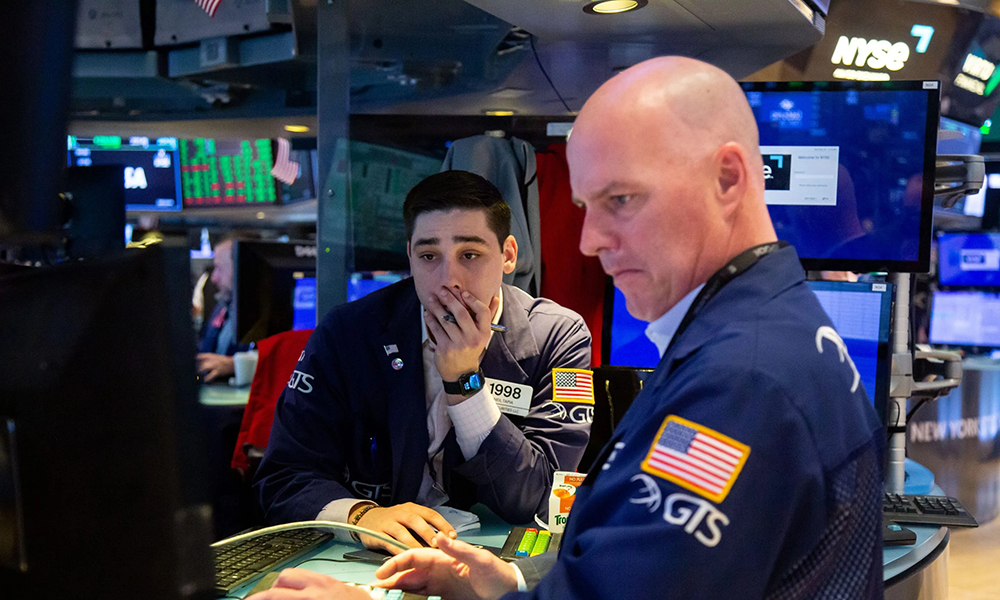
在瑞士信贷(Credit Suisse)倒闭以及美国历史上第二大银行和第三大银行倒闭之后,机构投资者感到担忧——但不仅仅是担心银行业危机或者潜在的经济衰退。世界顶级投资者认为,最近的金融事故[至少在一定程度上是由美联储(Federal Reserve)的大举加息造成的],使20世纪70年代式的滞胀成为更可怕的威胁。
美联储已经在努力通过加息来解决高通胀和低增长这一有毒组合,但现在他们必须在金融不稳定的情况下这样做,使得继续加息带来的风险更大。正如亿万富翁投资者比尔·阿克曼于3月21日在推特(Twitter)上所说的那样,银行业危机“仍未得到解决”,这意味着“在这种环境下,美联储不应该继续加息,给系统增加额外的压力。”
在美国银行(Bank of America)今年3月进行的基金经理调查中,约88%的基金经理表示,他们预计未来12个月美国经济都将面临滞胀风险(这在一定程度上是由于银行业危机给美联储带来障碍),这一比例高于今年2月的83%。
美国银行的分析师在回应中写道:“投资者从未对经济前景抱有如此强烈的(悲观)信念。”他们指出,对经济滞胀的预期已经连续10个月保持在80%以上,创历史新高。在硅谷银行于今年3月10日至3月16日倒闭期间,约244名基金经理参与了此次调查,他们管理的资产规模为6,210亿美元。
在接受美国银行调查的基金经理中,84%的基金经理认为未来12个月通胀将从目前的高水平略有下降,但大多数人还认为,今年不太可能回落至接近美联储2%的目标。最重要的是,51%的投资者预计,随着银行业不稳定的持续,经济增长将放缓,从而为滞胀奠定基础。这一比例高于今年2月的35%的低点,也是自2022年11月以来的最高比例。
美国公众第一次意识到滞胀是在20世纪70年代,当时由于越南战争(Vietnam War)和旨在消除贫困的“伟大社会”(Great Society)社会支出计划,联邦赤字激增,加剧了通货膨胀。再加上阿拉伯各国实施的石油禁运导致能源价格在20世纪70年代末飙升,当时的美联储主席保罗·沃尔克面临着一项艰巨的任务,即恢复价格稳定。他设法摆脱经济滞胀的唯一方法是通过“暴力加息”,最终导致双底衰退。
经济学家一直警告说,通货膨胀率创下近40年来的新高和经济增长放缓的情况下,类似20世纪70年代式的滞胀可能会在一年多的时间内卷土重来。长期以来,投资者一直认为“滞胀”对他们和美国经济的威胁比经济衰退更大。主要原因有两个:首先,这种经济现象通常是通过激进加息来解决,就像沃尔克时期那样,这种加息不仅会导致正常的衰退,还会导致严重的衰退,甚至是多次衰退;其次,滞胀往往会压低股价。
摩根士丹利财富管理公司(Morgan Stanley Wealth Management)的首席信息官莉萨·沙利特于3月20日下调了对美股的评级(原因是“美国出现滞胀的可能性更大”),理由是美联储在银行接连倒闭后无法通过加息来对抗通胀。
“遗憾的是,美联储陷入了困境。”她在给客户的一份说明里写道。“尽管美国需要继续加息以对抗通胀,但由于最近发生的事件,美联储应该按下加息‘暂停键’。股市需要修正来反映风险因素的增多。”(财富中文网)
译者:中慧言-王芳
在瑞士信贷(Credit Suisse)倒闭以及美国历史上第二大银行和第三大银行倒闭之后,机构投资者感到担忧——但不仅仅是担心银行业危机或者潜在的经济衰退。世界顶级投资者认为,最近的金融事故[至少在一定程度上是由美联储(Federal Reserve)的大举加息造成的],使20世纪70年代式的滞胀成为更可怕的威胁。
美联储已经在努力通过加息来解决高通胀和低增长这一有毒组合,但现在他们必须在金融不稳定的情况下这样做,使得继续加息带来的风险更大。正如亿万富翁投资者比尔·阿克曼于3月21日在推特(Twitter)上所说的那样,银行业危机“仍未得到解决”,这意味着“在这种环境下,美联储不应该继续加息,给系统增加额外的压力。”
在美国银行(Bank of America)今年3月进行的基金经理调查中,约88%的基金经理表示,他们预计未来12个月美国经济都将面临滞胀风险(这在一定程度上是由于银行业危机给美联储带来障碍),这一比例高于今年2月的83%。
美国银行的分析师在回应中写道:“投资者从未对经济前景抱有如此强烈的(悲观)信念。”他们指出,对经济滞胀的预期已经连续10个月保持在80%以上,创历史新高。在硅谷银行于今年3月10日至3月16日倒闭期间,约244名基金经理参与了此次调查,他们管理的资产规模为6,210亿美元。
在接受美国银行调查的基金经理中,84%的基金经理认为未来12个月通胀将从目前的高水平略有下降,但大多数人还认为,今年不太可能回落至接近美联储2%的目标。最重要的是,51%的投资者预计,随着银行业不稳定的持续,经济增长将放缓,从而为滞胀奠定基础。这一比例高于今年2月的35%的低点,也是自2022年11月以来的最高比例。
美国公众第一次意识到滞胀是在20世纪70年代,当时由于越南战争(Vietnam War)和旨在消除贫困的“伟大社会”(Great Society)社会支出计划,联邦赤字激增,加剧了通货膨胀。再加上阿拉伯各国实施的石油禁运导致能源价格在20世纪70年代末飙升,当时的美联储主席保罗·沃尔克面临着一项艰巨的任务,即恢复价格稳定。他设法摆脱经济滞胀的唯一方法是通过“暴力加息”,最终导致双底衰退。
经济学家一直警告说,通货膨胀率创下近40年来的新高和经济增长放缓的情况下,类似20世纪70年代式的滞胀可能会在一年多的时间内卷土重来。长期以来,投资者一直认为“滞胀”对他们和美国经济的威胁比经济衰退更大。主要原因有两个:首先,这种经济现象通常是通过激进加息来解决,就像沃尔克时期那样,这种加息不仅会导致正常的衰退,还会导致严重的衰退,甚至是多次衰退;其次,滞胀往往会压低股价。
摩根士丹利财富管理公司(Morgan Stanley Wealth Management)的首席信息官莉萨·沙利特于3月20日下调了对美股的评级(原因是“美国出现滞胀的可能性更大”),理由是美联储在银行接连倒闭后无法通过加息来对抗通胀。
“遗憾的是,美联储陷入了困境。”她在给客户的一份说明里写道。“尽管美国需要继续加息以对抗通胀,但由于最近发生的事件,美联储应该按下加息‘暂停键’。股市需要修正来反映风险因素的增多。”(财富中文网)
译者:中慧言-王芳
In the wake of Credit Suisse’s demise, and the second- and third-largest bank failures in U.S. history, institutional investors are worried—but not just about a banking crisis or a potential recession. The world’s top investors think that the latest financial accidents, which were caused, at least in part, by the Federal Reserve’s rapid interest rate hikes, have made ‘70s-style stagflation an even more dire threat.
The Fed was already fighting to fix the toxic combination of high inflation and low growth with interest rate hikes, but now they must do so in the face of financial instability as well, making any additional interest rate hikes all the more risky. As Billionaire investor Bill Ackman put it in a Tuesday tweet, the banking crisis “remains unresolved” which means “this is not an environment into which the Federal Reserve should be raising rates and adding additional pressure on the system.”
Partly as a result of the roadblocks that the banking crises present for the Fed, some 88% of fund managers said they expect stagflation to continue over the next 12 months in Bank of America’s March Fund Manager Survey, up from 83% in February.
“Investors have never held such strong conviction about the economic outlook,” Bank of America’s analysts wrote of the responses, noting that expectations for economic stagflation have remained above 80% for a record 10 months in a row. Some 244 fund managers with $621 billion in assets under management participated in the survey, which took place during Silicon Valley Bank’s collapse between Mar. 10 and 16.
While 84% of fund managers surveyed by BofA said they believe inflation will fall slightly from current elevated levels over the next 12 months, most also believe a drop back to near the Fed’s 2% target rate isn’t in the cards this year. On top of that, 51% of investors expect weaker economic growth as banking instability continues, setting the stage for stagflation. That’s up from a low of 35% last month, and the highest number since November of last year.
The American public first became aware of stagflation in the ‘70s, when federal deficits boomed due to the Vietnam War and “Great Society” social spending programs meant to fight poverty, exacerbating inflation. Tack on the Arab oil embargo that sent energy prices soaring at the end of the decade, and then Fed Chairman Paul Volcker faced a difficult task in restoring price stability for Americans. The only way he managed to rid the economy of stagflation was through a series of aggressive interest rate hikes that led to a double-dip recession.
Economists have been warning that a similar ‘70s-style stagflation could return for over a year now amid 40-year high inflation rates and meek economic growth. And investors have long believed that “stagflation” is a greater threat to both them and the U.S. economy than a recession for two main reasons. First, the economic phenomenon is typically resolved, as it was under Volcker, by aggressive rate hikes that don’t just cause a normal recession, but a severe one, or multiple recessions. And second, stagflation tends to hold down stock prices.
Morgan Stanley Wealth Management’s CIO Lisa Shallett downgraded her rating for U.S. equities due to “greater chances of stagflation” on March 20, citing the Fed’s inability to raise rates to fight inflation following back to back bank collapses.
“Unfortunately, the Fed is boxed in,” she wrote in a note to clients. “While it needs to continue interest rate hikes to combat inflation, which remains stubbornly high, recent events might better be addressed with a pause. The stock market needs to correct to reflect heightened risks.”






